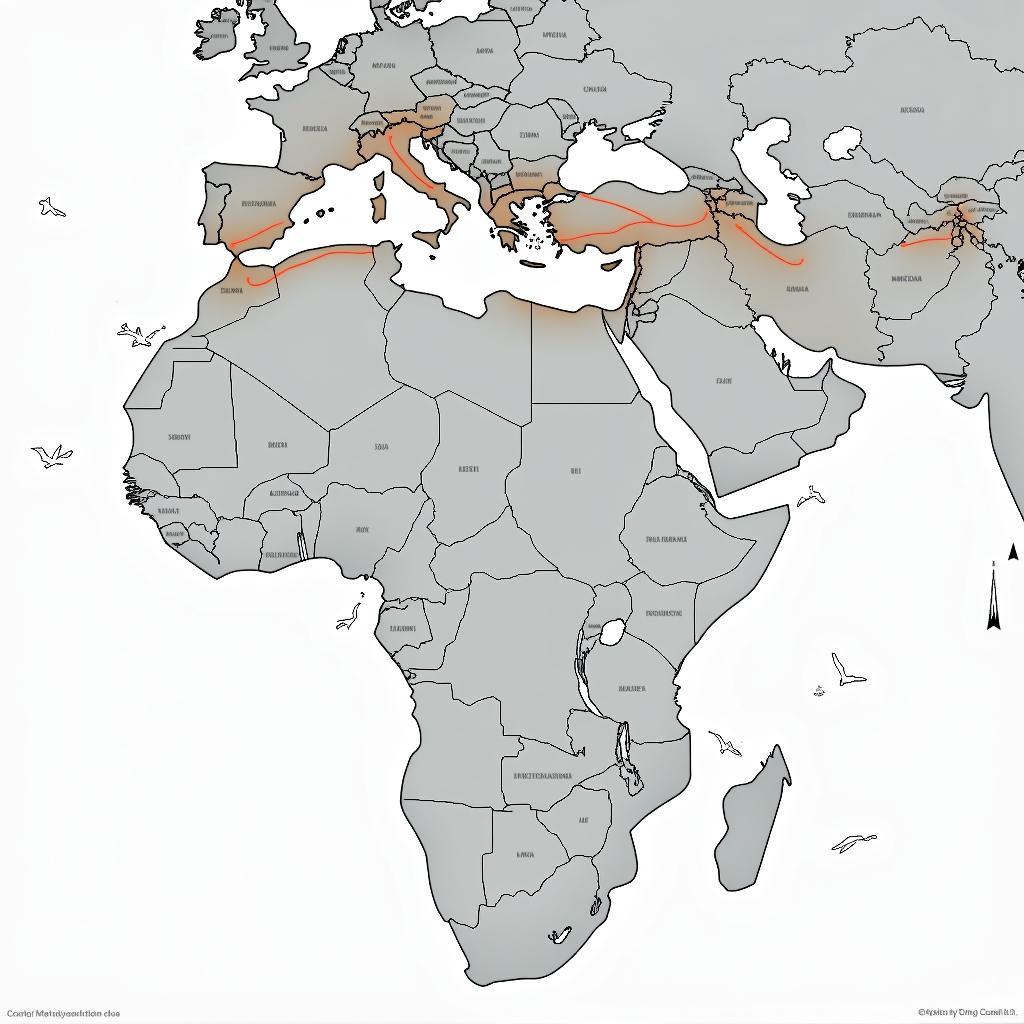Understanding the African Eurasian Migratory Waterbird Agreement
The African Eurasian Migratory Waterbird Agreement, often shortened to AEWA, plays a vital role in the conservation of migratory waterbirds that depend on habitats spanning across continents. This agreement brings together nations across Africa, Europe, and parts of Asia to work collaboratively in protecting these winged wonders and the crucial ecosystems they rely on.
 Map of the African Eurasian Flyway
Map of the African Eurasian Flyway
What is the African Eurasian Migratory Waterbird Agreement (AEWA)?
Established in 1995 under the umbrella of the Convention on the Conservation of Migratory Species of Wild Animals (CMS), AEWA is an intergovernmental treaty dedicated solely to the conservation of migratory waterbirds and their habitats. Recognizing that these birds are not confined by political boundaries, the agreement emphasizes international cooperation as the cornerstone for their effective protection.
Why is the African Eurasian Flyway Important?
Central to AEWA is the conservation of the African Eurasian Flyway, a vast migratory corridor that sees millions of waterbirds undertaking incredible journeys twice a year. This flyway is essentially a network of interconnected wetlands, rivers, and coastal areas stretching from the Arctic breeding grounds in Europe and Asia all the way down to the southern tips of Africa.
This intricate web of habitats provides crucial stopover points for these birds to rest, refuel, and breed. Threats such as habitat loss, climate change, and unsustainable hunting practices jeopardize the well-being of these migratory species, making international collaboration under AEWA indispensable for their survival.
How Does AEWA Protect Migratory Waterbirds?
AEWA takes a multi-faceted approach to protect migratory waterbirds:
- Legal Framework: The agreement provides a legal framework for countries to work together in managing and conserving shared waterbird populations.
- Action Plans: AEWA develops and implements species-specific action plans to address the conservation needs of particularly vulnerable waterbird populations.
- Habitat Conservation: A core focus is on protecting and managing crucial wetland sites across the flyway, ensuring these birds have safe havens to rest and refuel during their arduous journeys.
- Monitoring and Research: The agreement promotes monitoring programs to track waterbird populations, identify threats, and assess the effectiveness of conservation actions.
- Capacity Building: AEWA invests in training and capacity-building initiatives to equip professionals across the flyway with the necessary skills and knowledge to effectively implement conservation efforts.
The Impact of AEWA
Since its inception, AEWA has played a significant role in raising awareness about the plight of migratory waterbirds and driving concrete conservation action.
“The collaborative spirit of AEWA is its greatest strength,” says Dr. Naledi Modise, a conservation biologist specializing in African wetland ecosystems. “By bringing together governments, scientists, and conservationists, AEWA fosters a unified approach to tackling the complex challenges facing migratory waterbirds across their entire migratory range.”
The agreement has facilitated the establishment of numerous protected areas across the flyway, contributing significantly to the conservation of vital habitats. It has also been instrumental in implementing sustainable hunting practices in some regions, ensuring that hunting remains at sustainable levels.
The Future of AEWA
While AEWA has made commendable strides in migratory waterbird conservation, challenges remain. Climate change, habitat degradation, and illegal killing continue to pose serious threats. Moving forward, strengthening international cooperation, securing adequate funding, and engaging local communities will be crucial in ensuring the long-term survival of these remarkable creatures and the vital ecosystems they depend upon.
The African Eurasian Migratory Waterbird Agreement serves as a powerful reminder that conservation transcends borders. By working together, nations along the African Eurasian Flyway can ensure that future generations inherit a world where the skies are filled with the awe-inspiring spectacle of migratory waterbirds in flight.
FAQ
1. What are some examples of migratory waterbirds protected under AEWA?
AEWA covers a wide range of species, including ducks, geese, swans, waders, flamingos, and pelicans.
2. How many countries are currently party to AEWA?
As of 2023, AEWA has 81 Parties, including 38 African countries.
3. How can individuals contribute to the conservation of migratory waterbirds?
Supporting conservation organizations, practicing responsible birding, reducing your environmental footprint, and advocating for wetland conservation are all ways to make a difference.
Need More Information?
For further inquiries, please contact us at:
Phone Number: +255768904061
Email: kaka.mag@gmail.com
Address: Mbarali DC Mawindi, Kangaga, Tanzania
Our customer support team is available 24/7 to assist you. You can also find more information on our website, particularly resources on the African Eurasian Flyway.


